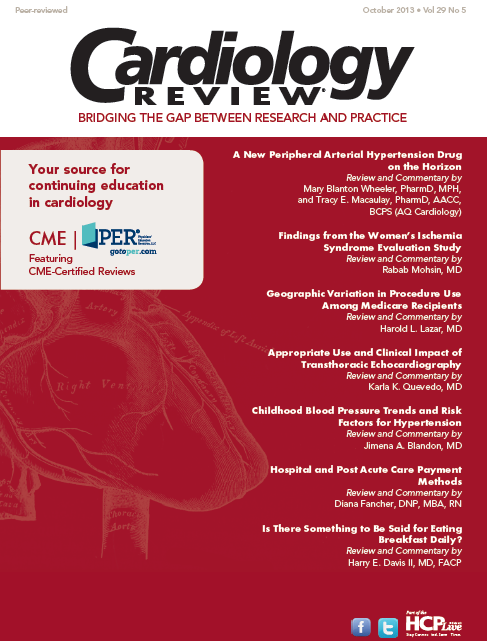Publication
Article
Cardiology Review® Online
News & Trends
AHA Urges Call to Action on Unhealthy Behaviors
The American Heart Association (AHA) issued a call to action, asking clinicians to put more emphasis on addressing health risk behaviors in addition to risk biomarkers to help more Americans improve their cardiovascular health into old age.
The AHA Science Advisory, published online in Circulation, noted that health care providers need to target unhealthy behaviors—not just biomarkers like blood pressure, lipid levels, and body weight — in order to reduce the burden of cardiovascular disease (CVD) in the United States by the end of the decade.
The advisory said that health care providers have to be key players in efforts on both the individual and population levels to help people make better lifestyle choices. Health care providers are called upon to perform 2 main functions:
- Intervene directly and as members of interdisciplinary health care teams to help individual patients adopt healthier lifestyles.
- Advocate for a health care system and policy improvements to address the behavior change needs of an entire population more effectively.
The advisory points out that annual costs related to CVD are projected to increase from $272 billion in 2010 to $818 billion in 2030. This highlights the need for more aggressive steps to meet AHA’s goal of improving the cardiovascular health of all Americans by reducing deaths from CVD by 20% and from stroke by 20%. “To avoid bankrupting the health care system we must improve the distribution of cardiovascular health levels across the population by preserving cardiovascular health from childhood, and by treating health risk behaviors, to help more individuals improve their cardiovascular health into older age.”
In addition to promoting healthy lifestyle choices, the AHA recommends treating unhealthy behaviors like smoking, poor diet, and physical inactivity in addition to risk biomarkers. The advisory provides an overview of some ways physicians can better communicate and help patients change unhealthy behaviors.
Ankle-Brachial Index of Limited Value for CVD Prediction
In an effort to assist the US Preventive Services Task Force (USPSTF) in updating its 2005 recommendations recommending against routine screening for peripheral artery disease (PAD) in primary care, researchers reviewed evidence on the ability of the ankle-brachial index (ABI) to predict cardiovascular disease (CVD) morbidity and mortality independent of Framingham Risk Score (FRS) factors in asymptomatic adults. The investigators also studied the benefits and harms of treating screen-detected PAD in adults.
Jennifer S. Lin, MD, MCR, and colleagues from Kaiser Permanente Northwest in Portland, OR, used Medline and the Cochrane Central Register of Controlled Trials (1996 to 2012) as a database. A large meta-analysis of 43,919 people found that adding ABI to FRS factors probably has limited value for predicting coronary artery disease (CAD) or CVD, and that treatment benefits for asymptomatic adults with screen-detected PAD are not proven.
The review represents an analysis of all new evidence presented since the USPSTF made its 2005 presentation. “Despite the accrual of new evidence, we found limited evidence to support the added value of the ABI in current CAD or CVD risk prediction, as well as limited trial evidence for treatment of CVD in persons with asymptomatic or minimally symptomatic PAD,” the investigators said.
The study was published in the Annals of Internal Medicine on September 3, 2013.
In an accompanying article in the same issue of the journal, the USPSTF concludes that current evidence is insufficient to assess the balance of benefits and harms of screening for PAD and CVD risk assessment with the ABI in adults.
FDA Approves New Drug for 2 Types of PAH
The FDA has approved riociguat (Adempas) for the treatment of pulmonary arterial hypertension (PAH) and chronic thromboembolic pulmonary hypertension (CTEPH). Riociguat is a product of Bayer. It is a vasodilator that restores the nitric-oxide-soluble guanylate cyclase-cyclic guanosine monophosphate (NO-sGC-cGMP) pathway by direct stimulation of sGC, independent of NO, and sensitizing sGC to low levels of NO.
Riociguat is the first in its drug class approved for PAH and the first drug of any class shown to be effective for CTEPH. Riociguat is indicated for the treatment of adults with persistent/recurrent CTEPH (WHO group 4) after surgical treatment or inoperable CTEHP to improve exercise capacity and WHO functional class; and the treatment of adults with PAH (WHO group 1) to improve exercise capacity, improve WHO functional class, and delay clinical worsening.
In clinical trials of riociguat in CTEPH, the drug was associated with an average improvement in a 6-minute walk distance that was 46 m more than in those treated with placebo. In PAH, the 6-minute walk distance in patients treated with riociguat improved by an average of 46 m more than in placebo-treated patients.
Common side effects observed in patients treated with riociguat included headache, dizziness, indigestion, peripheral edema, nausea, diarrhea, and vomiting.
Riociguat carries a boxed warning alerting that the drug should not be used in pregnant women because it can harm the developing fetus; female patients can receive the drug only through its REMS-restricted distribution program.






